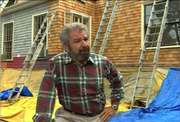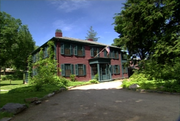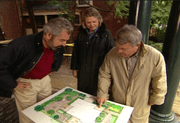We're in Cambridge, just across the Charles River from Boston, Massachusetts.
And I'm standing in Harvard Square.
Really known around the world as an intellectual center, also a hot spot for night life and for shopping.
We're going to be starting an architectural tour with Brian Pfeiffer, who is the vice president for Building Conservation at the Society for the Preservation of New England Antiquities.
And Brian, is this really a good spot to begin our tour?
Absolutely.
This is a terrific spot.
Within an easy circumference of us, you can find three centuries of Cambridge architecture.
Starting with the Wadsworth house, was built in the 1720's for the president of Harvard.
But going on to College Hall over here, which was built in the nineteenth century to house students.
And continuing to the twentieth century, the controversy over existing buildings that are proposed to be taken down for modern buildings.
Exactly .
Harvard Square, which still represents wooden buildings from two centuries ago, but most of us think of Harvard Yard is being all Georgian brick buildings, right?
Well, there is a lot of Georgian and brick, but that's just around the corner.
It turns itself slightly away from Harvard Square.
The old yard faces the common and has on it the Massachusetts Hall of the early eighteenth century, which is a
dormitory and classroom building.
Then Harvard Hall, and then at the end of it, it has a wonderful granite building designed by Bullfinch which really defines much of what people think of as Harvard College and Harvard Yard today.
And of course, just outside the yard, we have one of my favorite landmarks, Memorial Hall, one of the most exuberant examples of nineteen century architecture around.
And the history of Cambridge involves two social groups, the Puritans who first came here as well as the British aristocrats, the Tories, right?
The Puritans came, in a way, to get away from the Church of England, to purify, to live a simpler life in New England and in the late seventeenth century though the Royal Governors, the Church of England came and established some small churches, and it was generally a wealthier sort of royally associated group who lived in a different way, and the Puritans didn't entirely like it.
But Cambridge had both living side by side and attending Harvard and attending church within a couple hundred yards of where we stand.
And some of them living in great elegance and others living in great simplicity.
Sure.
In Cambridge there are a number of houses like the Cooper Frost Austin House which is north of the square.
Center chimney houses built by Puritan farmers.
Very simple living.
Often, the cooking, eating, and sleeping arrangements were all in the same room.
Storage in the room above.
By contrast the Longfelllow House out on Brattle street is a house in the mid-eighteenth century, built for a wealthy Tory with plantations in the West Indies.
And the house shows it with its grand carving and center hallway and Palladian style.
Exactly.
Well thank you Brian.
Good, well, thank you.
That's a wrap.
Come home again next time when we'll get together with the architect and we'll talk about his ideas for changing the layout.
We'll also begin demolition and tour some neighboring shingle-style homes.
Until then, I'm Bob Vila.
It's good to have you home again.







